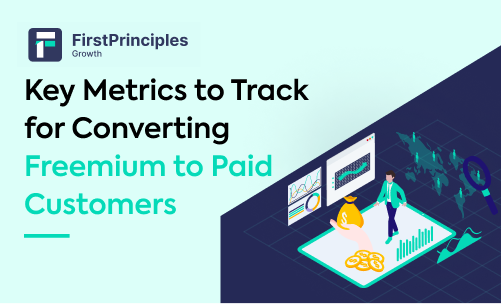
Home > Key Metrics to Track for Converting Freemium to Paid Customers
Table of Contents
Toggle
There’s no denying the fact that freemium models work wonders when it comes to driving traffic for SaaS companies. It’s also vital for any SaaS company to keep a constant check on the effectiveness of its pricing strategy. If left unchecked, a freemium pricing model has the power to cripple your SaaS company and crumble it to the ground.
Companies need to understand their customers better, motivate them to upgrade, and be vigilant about whether or not their strategies are yielding results otherwise it’s just shooting in the dark. Here are some of the key metrics that you should track for a better understanding of how to convert freemium to paid customers:
For SaaS companies offering a freemium plan, signup is the most important metric. Most SaaS companies adopt a freemium model just to drive sign-ups. This helps you build an email list of potential customers you can nurture.
Whether you’re offering a free trial or a freemium plan, for any SaaS startup the initial marketing goal is to drive signups. To work with this metric effectively, check the source of the traffic as well, as which marketing channel is contributing the most to lead generation, period and the various stages of the sales funnel.
You’ll also need to keep a check on how often your freemium customers are actively using your product. This will help you understand whether they’re having a valuable experience or not. To check what exactly drives this value, you need to identify the daily and monthly active users. Improvement in these numbers is an indication that you are moving in the right direction and that your freemium model is working.
Although DAU and MAU are considered to be vanity metrics by some, they give you an idea of how sticky your product is and how many users have returned to it after using it for the first time.
Stickiness = DAU / MAU
Where,
DAU = Daily Active Users
MAU = Monthly Active Users
CAC shows you exactly how much it cost you to acquire a customer and how much value it has brought to your business. To calculate this:
Total sales and marketing spend / Total number of new customers you added during a given period of time.
Once you’ve understood the CAC and identified which channel works the best for you – which one is the most profitable for your business, you can develop strategies accordingly to scale up your SaaS business.
A SaaS company often finds itself struggling to balance the 2 variables – CAC and LTV. To make your business a success, you’ll always want that both variables are balanced.
To reduce CAC, you can try A/B testing, to improve the conversion rates and minimize the follow-ups required. To track and calculate CAC you can either use the traditional spreadsheets or use QuickBooks and track the number of new paid users.
Although the free to the paid conversion rate for a SaaS company is normal, you also need to make sure it’s high enough to support your free customers. Getting traffic or ‘X’ number of subscribers can be your objective but let’s face it’s not your goal, it’s the revenue that matters.
To measure the conversion rate to a customer, we use the simple formula:
Conversion Rate to Customer = No. of Customers/Total no. of customers during that particular period.
The resultant will serve as a benchmark for how good a job you’ve done at turning leads into customers.
Recurring Revenue is the backbone of SaaS businesses, to analyze this you need to keep a track of the MRR(Monthly recurring Revenue) – a single, consistent number that helps you summarize all the revenue you receive from your paying customers. On the other hand, Churn MRR is the monthly revenue lost from cancellations and downgrades. It’s an estimate of the total loss a company has suffered and can be calculated as
Gross MRR churn = Total MRR Churn/ Total MRR x 100
Note: Total MRR Churn and Total MRR are per month. If this ratio is greater than 5% you’re losing a substantial amount of revenue due to downgrades and cancellations.
Being a SaaS company, apart from keeping a check on the free to paid conversion rate, you also need to look out for the bounce rate, especially for the pricing page. This metric will give you a better understanding of how effective your pricing model is and if there are any strategic changes that you might need to make to reduce the bounce rate.
Ideally, a bounce rate in the range of 26 – 40% is excellent. If your bounce rate is beyond that indicates that it’s time to update your pricing strategies or change your pricing model. You should constantly ask yourself: “How can I improve my current bounce rate?”
Make sure you set realistic goals to get proper “Bounce Rates” or “% Exit”, e.g., Say customers visited “x” pages before they signed up for a free trial, or spend “x” seconds on the pricing page, etc.
With that said, freemium is a model you can experiment with. All you need to do is keep a constant check on the above-mentioned metrics and make changes to your strategies accordingly.
Ameet Mehta‘s expertise lies in building revenue engines for technology-enabled companies and private equity investments. He began his journey with TechStars Chicago and has since founded and acquired several companies through FirstPrinciples Holding Company. The FirstPrinciples portfolio generates over $7M in revenue/year with most companies in the SaaS space. He...